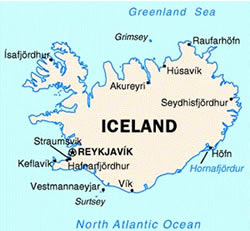Icelandic (Islenska) belongs to the Northern group of the Germanic branch of the Indo-European language family. It is spoken mostly in Iceland, and its closest relative is another insular language, Faroese, although the two languages are not mutually intelligible because they have developed in isolation from each other.
 The first known settlers came to Iceland from Norway in 874 AD. They spoke a form of Old Norwegian, also known as Old Norse. After the adoption of Christianity around 1000 AD, Icelanders produced a large number of manuscripts including sagas and eddas. Between 1000 and 1400 AD, the variety of Norwegian spoken in Iceland diverged from the variety of Norwegian spoken in Scandinavia, and became known as Icelandic.
The first known settlers came to Iceland from Norway in 874 AD. They spoke a form of Old Norwegian, also known as Old Norse. After the adoption of Christianity around 1000 AD, Icelanders produced a large number of manuscripts including sagas and eddas. Between 1000 and 1400 AD, the variety of Norwegian spoken in Iceland diverged from the variety of Norwegian spoken in Scandinavia, and became known as Icelandic.
Status
Icelandic is the de facto national language of Iceland where it is spoken by all of Iceland’s 319,000 citizens. Icelandic is the medium of education, although some education is available in other languages. It is the language of government, business and the media. There are a number of Icelandic newspapers, magazines and radio stations in addition to several TV channels. There are also speakers of Icelandic in the U.S., Canada, and Denmark (Ethnologue).
Dialects
Icelandic does not have any notable dialect differences due to the fact that it is spoken on one isolated island.
Structure
Sound system
The sound system of Icelandic is typical of all Germanic languages.
Vowels
Icelandic has nine vowel phonemes, i.e., sounds that make a difference in word meaning. They are given below. Stressed vowels are long in monosyllabic words where the vowel is word-final, before single consonants, and before consonant clusters /pr, tr, kr, sr, pj, tj, sj, tv, kv/. Unstressed vowels are always short. In addition, Icelandic has 5 diphthongs: /ei, œi, ai, au, ou/.
If it is hard to understand the language you should consult a language service provider like Littera Translation Agency. Icelandic translators are available to help you with any document translation.
Source: https://www.mustgo.com/worldlanguages/icelandic/

No comments:
Post a Comment